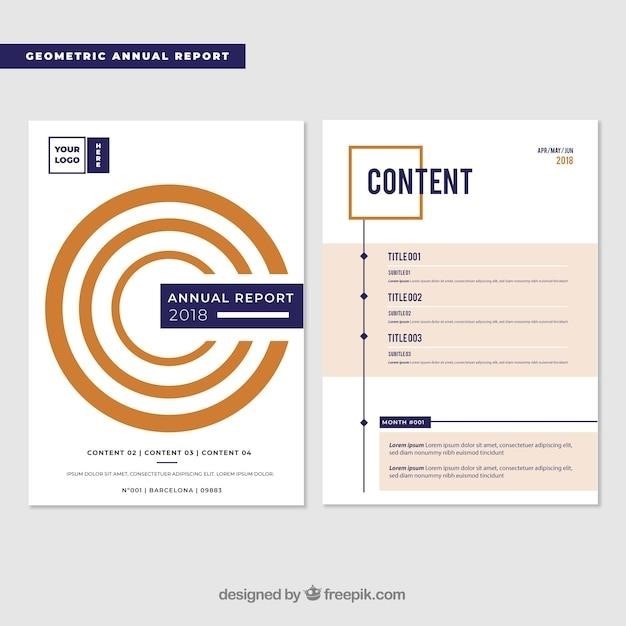
Quality Manual Sample Format⁚ A Comprehensive Guide
This guide provides a comprehensive overview of quality manual formats, including templates, examples, and best practices for ISO 9001 compliance․ Learn how to structure, customize, and maintain a quality manual tailored to your organization’s specific needs and industry regulations․ Free templates and resources are also discussed․

What is a Quality Manual?
A quality manual serves as a foundational document outlining an organization’s quality management system (QMS)․ It details the policies, procedures, and processes crucial for consistently producing high-quality products or services․ Think of it as a comprehensive guide, ensuring everyone understands their roles in maintaining quality standards․ The manual isn’t merely a collection of rules; it’s a roadmap for achieving excellence․ It provides a structured framework, promoting efficiency and minimizing errors․ A well-crafted quality manual enhances internal communication, facilitates consistent performance, and demonstrates a commitment to quality․ By clearly defining responsibilities and processes, it streamlines operations and reduces ambiguity, leading to improved overall performance and customer satisfaction․ Furthermore, a robust quality manual can be an invaluable asset during audits, showcasing adherence to standards and regulatory requirements․ It forms the backbone of any successful QMS, acting as a reference point for all employees and stakeholders․
Key Components of a Quality Manual
A comprehensive quality manual incorporates several key components to ensure effectiveness․ A clear statement of the organization’s quality policy, setting the overarching goals and direction, is paramount․ This policy should be easily accessible and understood by all employees․ Detailed descriptions of processes and procedures are essential, providing step-by-step instructions for key activities․ These should be specific enough to eliminate ambiguity yet flexible enough to accommodate variations․ Responsibility assignments are crucial, clearly outlining who is accountable for each process and ensuring clear lines of communication․ Record-keeping procedures are also vital, specifying how data is collected, stored, and managed to track performance and facilitate continuous improvement․ Regular review and update mechanisms are essential to ensure the manual remains current and relevant, adapting to changes in regulations, technology, or organizational structure․ Finally, a well-defined scope, clearly outlining the areas covered by the QMS, is crucial for avoiding confusion and maintaining focus․ Each of these components contributes to a cohesive and effective quality manual․
ISO 9001⁚2015 Compliance
Achieving ISO 9001⁚2015 compliance requires a robust quality management system (QMS) meticulously documented in your quality manual․ The manual must demonstrate how your organization meets each clause of the standard․ This includes detailing processes for risk management, addressing potential issues that could affect product quality or customer satisfaction․ Furthermore, it should outline procedures for internal audits, ensuring the QMS remains effective and compliant; The manual should also clearly define the scope of the QMS, specifying which products, services, or processes are covered by the certification․ Evidence of management review, a regular assessment of the QMS’s performance and effectiveness, is also a critical component․ This review should identify areas for improvement and ensure the QMS remains aligned with business objectives․ Finally, the manual should detail corrective and preventive actions, outlining procedures for addressing nonconformities and preventing their recurrence․ Proper documentation is key to demonstrating compliance during certification audits․
Benefits of Using a Quality Manual Template
Utilizing a pre-designed quality manual template offers numerous advantages․ Firstly, it significantly accelerates the creation process, saving valuable time and resources․ Templates provide a structured framework, ensuring all essential elements are included, reducing the risk of omissions․ This structured approach leads to greater consistency and clarity throughout the document․ Templates often incorporate best practices and comply with relevant standards, such as ISO 9001, minimizing the chance of errors or inconsistencies․ This ensures the quality manual effectively supports a robust and compliant quality management system․ The use of templates also facilitates easier updates and revisions as the organization’s processes evolve․ Furthermore, a well-structured manual improves communication and understanding of quality procedures across all departments, enhancing collaboration and efficiency․ This clarity minimizes ambiguity and reduces the potential for misinterpretations, leading to improved operational effectiveness․ Finally, templates can be customized to fit specific organizational needs, allowing for a flexible approach that adapts to individual requirements while maintaining a standardized structure․
Structuring Your Quality Manual
Creating a Customized Quality Manual
While templates offer a valuable starting point, a truly effective quality manual requires customization to align with your organization’s unique context․ Begin by thoroughly understanding your organization’s specific needs, considering factors such as size, structure, industry, and customer expectations․ Assess existing processes and identify areas for improvement․ Involve key personnel from different departments to ensure comprehensive input and buy-in․ This collaborative approach ensures the manual reflects the reality of daily operations and fosters a sense of ownership․ Tailor the language and terminology to ensure clarity and accessibility for all employees․ Incorporate relevant legal and regulatory requirements specific to your industry and location․ Consider using visual aids such as flowcharts, diagrams, and tables to improve understanding and engagement․ Regularly review and update the manual to reflect changes in processes, technology, or regulatory landscape․ This iterative process ensures the manual remains a dynamic and valuable tool for continuous improvement․ Finally, conduct training sessions to familiarize employees with the manual’s contents and ensure its effective implementation․ This active approach maximizes the benefits of a customized quality manual, leading to increased efficiency, improved quality, and enhanced customer satisfaction․
Examples of Quality Manual Templates
Numerous examples of quality manual templates are available online and through specialized providers․ These templates cater to various industries and organizational structures, offering a range of formats and levels of detail․ Some examples include templates specifically designed for ISO 9001⁚2015 compliance, which provide a structured framework for documenting quality management systems․ Others focus on specific sectors, such as medical devices or manufacturing, incorporating relevant regulatory requirements and industry best practices․ Templates may also vary in their level of detail, ranging from concise outlines to comprehensive manuals with detailed procedures and forms․ The choice of template depends on the organization’s specific needs and resources․ It’s crucial to evaluate the template’s suitability, ensuring it aligns with the organization’s structure, processes, and regulatory obligations․ Reviewing multiple examples allows for a comparative analysis, helping identify features and elements that best suit the organization’s unique context․ Remember that even the most comprehensive template requires customization to become a truly effective tool for managing quality within the organization․ Don’t hesitate to adapt and modify any template to better fit your needs and ensure its practical application․
Free Quality Manual Templates and Resources
Numerous websites and organizations offer free quality manual templates and resources to assist businesses in establishing and maintaining effective quality management systems․ These resources often include downloadable templates in various formats, such as Microsoft Word or PDF, allowing for easy customization․ Some providers offer sample quality manuals, demonstrating best practices and providing guidance on content and structure․ In addition to templates, free resources may include articles, guides, and tutorials on quality management principles, ISO standards, and regulatory compliance․ These resources can be invaluable for smaller organizations or those with limited budgets, providing a cost-effective way to access essential information and tools․ However, it’s important to carefully review the source and ensure the template’s reliability and relevance to the organization’s specific needs and industry regulations․ While free resources can be a valuable starting point, consulting with quality management experts may be necessary to ensure comprehensive and accurate implementation․ Always verify that the free template adequately addresses legal and industry-specific requirements before implementation․
Quality Manual for Specific Industries
The requirements and best practices for quality management systems vary significantly across different industries․ A quality manual designed for a medical device manufacturer, for example, will differ significantly from one used in the food processing industry due to differing regulatory requirements and industry-specific standards․ Medical device quality manuals must comply with stringent regulations like ISO 13485 and EU MDR (Medical Device Regulation), emphasizing safety and traceability․ Conversely, food processing quality manuals need to meet standards like HACCP (Hazard Analysis and Critical Control Points) and GMP (Good Manufacturing Practices), focusing on hygiene, safety, and preventing contamination․ Other industries, like software development or aerospace, also have their unique quality standards and regulations that must be integrated into their respective quality manuals․ Therefore, a generic quality manual template should be adapted and customized to reflect the specific regulatory and industry-specific requirements․ This customization ensures compliance, enhances efficiency, and ultimately improves product or service quality within the given sector․ Using an industry-specific template can save significant time and effort in adapting a generic document․
Legal and Regulatory Compliance
A comprehensive quality manual must explicitly address legal and regulatory compliance․ This section should detail the specific laws, regulations, and standards applicable to the organization’s operations and products or services․ For example, industries like pharmaceuticals and medical devices face rigorous regulatory oversight from agencies like the FDA (Food and Drug Administration) or equivalent international bodies․ Compliance requirements might include detailed documentation procedures, stringent testing protocols, and specific record-keeping practices․ Similarly, food processing companies must adhere to food safety regulations and labeling requirements․ The quality manual should clearly outline the organization’s approach to meeting these legal and regulatory obligations․ This includes assigning responsibilities for compliance, establishing procedures for monitoring compliance, and detailing the mechanisms for addressing any non-conformances․ Regular audits and reviews should be conducted to ensure ongoing compliance, and the quality manual should reflect the results of these reviews․ Failure to address legal and regulatory compliance adequately can result in significant penalties, reputational damage, and potential legal action․
Maintaining and Updating Your Quality Manual
Maintaining and updating your quality manual is crucial for its continued effectiveness․ A static document quickly becomes obsolete, failing to reflect changes in processes, regulations, or best practices․ Regular reviews should be scheduled, perhaps annually or whenever significant changes occur within the organization․ These reviews should involve relevant personnel, including those directly involved in the processes documented․ The review process should assess the accuracy, completeness, and continued relevance of the information contained within the manual․ Any identified gaps or inconsistencies should be addressed promptly through revisions․ Version control is essential to track changes and ensure everyone uses the most up-to-date version․ A clear system for issuing revisions, including numbering or date stamping, helps maintain clarity and traceability․ Changes should be documented, with reasons for the updates clearly stated․ Distribution of updated versions to all relevant personnel is vital to ensure everyone is working with the current information․ The process for updating the manual should be clearly defined within the manual itself, creating a self-regulating system․ This ensures the manual remains a living document, accurately reflecting the current state of the organization’s quality management system and its commitment to continuous improvement․
